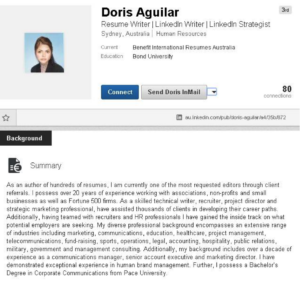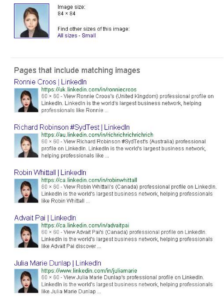So there you are — you've been with the same company for years, so long that you can hardly remember doing anything else. And you've been happy in your job, focussed on doing the task at hand, not really thinking about what might come next. But then it changes. Your job is no more. After all that time, you're back on the market, back to the résumé refining, application sending, and suit and tie auditions.
‘You'd better get yourself on LinkedIn', a friend says. ‘What's LinkedIn?'
While awareness of LinkedIn is pretty widespread these days (5 million users in Australia alone), there are still a lot of professionals who've never explored the platform or got around to filling out a profile. This is particularly true of long-tenured employees – if you've been stably employed for the last 5-10 years, there's a good chance you've never even considered LinkedIn and its possible value to you.
That knowledge gap, combined with the increasing use of LinkedIn data in the recruitment process, leaves many people seeking answers on how best to represent themselves on the world's biggest professional network.
One key element of LinkedIn is making connections. Having people willing to connect with you is effectively an endorsement of your professional capability, so it's worth building your connection count, if you can.
But outside of the people you know and have worked with, how do you go about ‘building' connections? How many connections do you need to be seen as a good prospect? And the big one that comes up pretty regularly – should you accept connection requests from anyone and everyone? While the answers can vary, dependant on your position and purpose, there are a couple of things you need to look out for as you go about constructing your extended LinkedIn network.
Making a connection
Making connections is a core fundamental of LinkedIn. The ‘social' in ‘social media' dictates that establishing connections and interacting is an important element of the process, so to be meeting the intended purpose of the platform, you need to establish connections as a start. The logic behind building connections is sound – someone with a long career history but only twenty connections would probably suggest something's not quite right.
While the actual number isn't the be all and end all, it definitely is something, and it's something you need to be aware of from your prospective employers' point of view. Having only a few connections suggests that other professionals aren't willing to connect with you, or you're not willing to connect with them – and either way, it's not a great look. It's similar to a follower count on Twitter – having two thousand followers doesn't necessarily mean you're influential, but it still represents something, that people are willing to connect with you and hear what you have to say.
The more complex question is how many connections do you need to ensure you're representing yourself in the best possible way? Various studies have been undertaken on the average number of connections on LinkedIn, most of which indicate that there's about a 50-50 split between those who have more than 500 connections and those who don't – 500 being the magic number, as LinkedIn doesn't show how many connections you have beyond this, the total switching to ‘500+' (LinkedIn's intention is not to have it become a popularity contest, but to use connection count as some indicator of professional standing).
One of the best guidelines on how many connections you should have comes from social media marketing thought leader Neal Schaffer, whose theory is that you should aim to have 10 times as many connections as your age. Schaffer's contention is built around the idea that you're likely to be meeting well over ten people per year, and you should be making the effort to connect with at least some of them. If you are, then it's not a stretch to imagine that ten connections per year could work – and if it doesn't, it may be something to aspire in for future interactions.
The core principle is that your connections should matter, and as such, the number itself is not the critically important point. You should be seeking to establish connections with people, rather than just connecting – there's no point having two thousand connections if you're not interacting with any of them either way.
From a functional standpoint, your connections are only as valuable as you're able to make them, through working with them and building relationships. In terms of perception view, the number is relevant, but how relevant depends on the specific person making the assessment and the accompanying details of your professional history. The ‘age X 10' approach is a good target to aim for – but then, of course, setting a target like that is often much easier than the actual doing.
‘Hey, didn't we meet at…'
As in any scenario, making connections can be hard. Sure, some people can waltz into a room and work the crowd and have people clamouring to be their next best friend, but for others, meeting new people can be difficult. You know you need to make connections, but if you've already gone through everyone you've worked with or gone to school with or met through someone else and you're still not building a solid network, what then?
The key to building connections is getting involved.
LinkedIn Groups are a great way to meet likeminded folk on topics you're interested in and on which you have expertise to share.
LinkedIn opened their publishing platform to everyone in early 2014, so now anyone can publish long-form blog posts, enabling you to share your thoughts on the latest industry changes and updates, and those posts are a great way to build connections – you might look to start a conversation with anyone who comments or interacts your post and build relationships that way, for example.
There's a heap of ways to utilise LinkedIn's features to facilitate conversations or get in touch with people in your industry, and it's worth exploring all these options if you're concerned about your increasing your connection count.
Again, the important part is the interaction, knowing who you're connecting with and why, and using those connections to build opportunities, rather than just metrics. But of course, if you're really concerned, if you think that connection count really matters, you could go the other route. You could go the way of the LION.
King of the Jungle?
At some point in your LinkedIn experience, you're going to come across a LION. LION, in the LinkedIn world, stands for ‘LinkedIn Open Networker'. LIONs will connect with anyone and everyone, within reason. LIONs are aiming to expand their networks as much as they possibly can – doesn't matter if they don't know you or what you do. LIONs crave connections.
Seems odd, right? All the LinkedIn official documentation advises against connecting with people you don't know, yet these LIONs just take on anyone into their network. But it's an interesting strategy, and one which does have its own logic and benefits.
LIONs are aiming to hit the LinkedIn ceiling, which is 30,000 connections. They'll display their connection counts in their profile headlines, they wear their numbers like a badge of pride. But while it can be valuable, it's also questionable as to how effective that strategy can be. Like, you'd think a lot of those disengaged connections are tuning them out, and if 95% of those connections aren't listening, and only 5% are, that connection number's not really indicative of anything much, right? But then again, if it's 5% of 30,000 people…
There are various approaches to connecting and none is definitively correct, but what you do need to look out for is spammers. That's right, LinkedIn has spammers too, and they're after that which can hurt you the most – your personal details.
Changing faces
The only definite spam profiles I've come across on LinkedIn have always been startlingly obvious – though, I say that now, after experiencing them quite a bit. Spammers will generally be people with no obvious connection to you or your industry – most of the ones I've found are ‘Résumé Writers' or ‘Recruitment Managers', people who're connecting with you in that context, as opposed to being within your actual area of interest. Here's an example of one who tried to connect with me:

At first glance, this doesn't look like anything too out of the ordinary, all the details are in the right places, the info seems legit, etc. But her face, it looks a bit off, doesn't it? What's up with that? After a quick Google image search I found:

For some odd reason, LinkedIn spammers will often use the same image on a heap of profiles – and not only that, they'll cut and paste different faces onto the same image, creating this odd, uncanny valley, feel, like something's not quite right. And something isn't right, they're spammers and they're trying to connect with you for their own insidious purposes. What are those purposes, you ask?
LinkedIn spammers primarily make money from information, by stealing your personal data. For example, if I go to a profile of someone I'm not connected to, I'll see this in beneath their profile image:

But if I go to someone I am connected to, I get:

All their contact info, all their profile information shows up. I can now put together a full data dossier of who this person is, where they've worked, their contact e-mail, phone number – in many cases their address. Spammers connect with as many people as they can to collect this data, which they can then on-sell to whomever might want to buy it.
An annoyance, as with any spam, but generally easy to spot, if you know what you're looking for – anyone who you don't know, who has no relation to you or your industry and for whom there's no obvious reason for them to be sending you a request to connect, pretty likely they're spammers and should be dealt with accordingly. Helpfully, LinkedIn offers a handy ‘Report as Spam' option on any connection request, click on it and save us all from future hassle.
The science of connectivity
Of course, not everyone needs to prove their value via LinkedIn metrics. Not every hiring manager in every business is going to check your LinkedIn profile, and of the ones that do, not all of them will care how many connections you do or don't have. But a rising number of recruiters are sourcing or vetting candidates based on their LinkedIn profile information. How big a factor your profile is is dictated by the individual hiring manager making the call.
While there are no definitive rules on what you need to do, hopefully these guidelines can help you create and improve your LinkedIn profile to best support your professional skills and experience – whilst also saving you from the hassle of some spammer clogging your inbox with ‘unbelievably amazing super' discount deals.
Latest.

Everything you need to kickstart your freelance career.
Job Seeker, Here to help

In an AI-driven world, humans are still irreplaceable.
Thought Leadership, Industry Trends

Maximising your team performance with competitive salaries.
Job Seeker, Industry Trends

